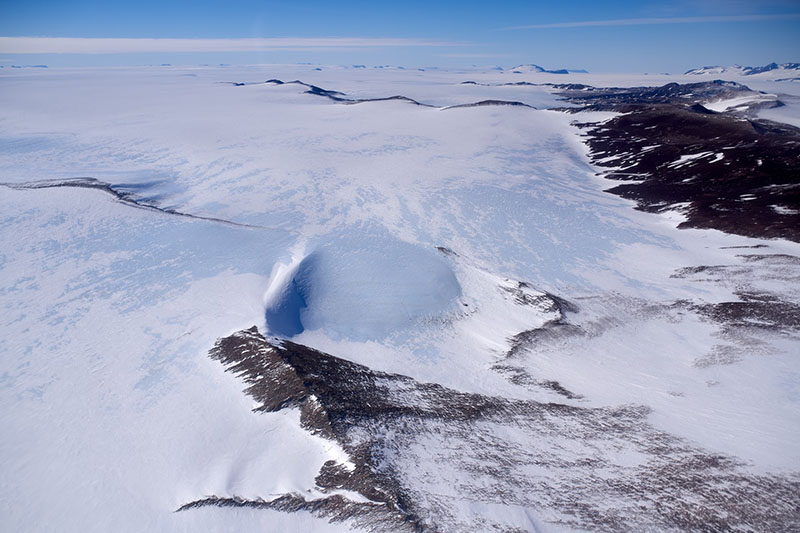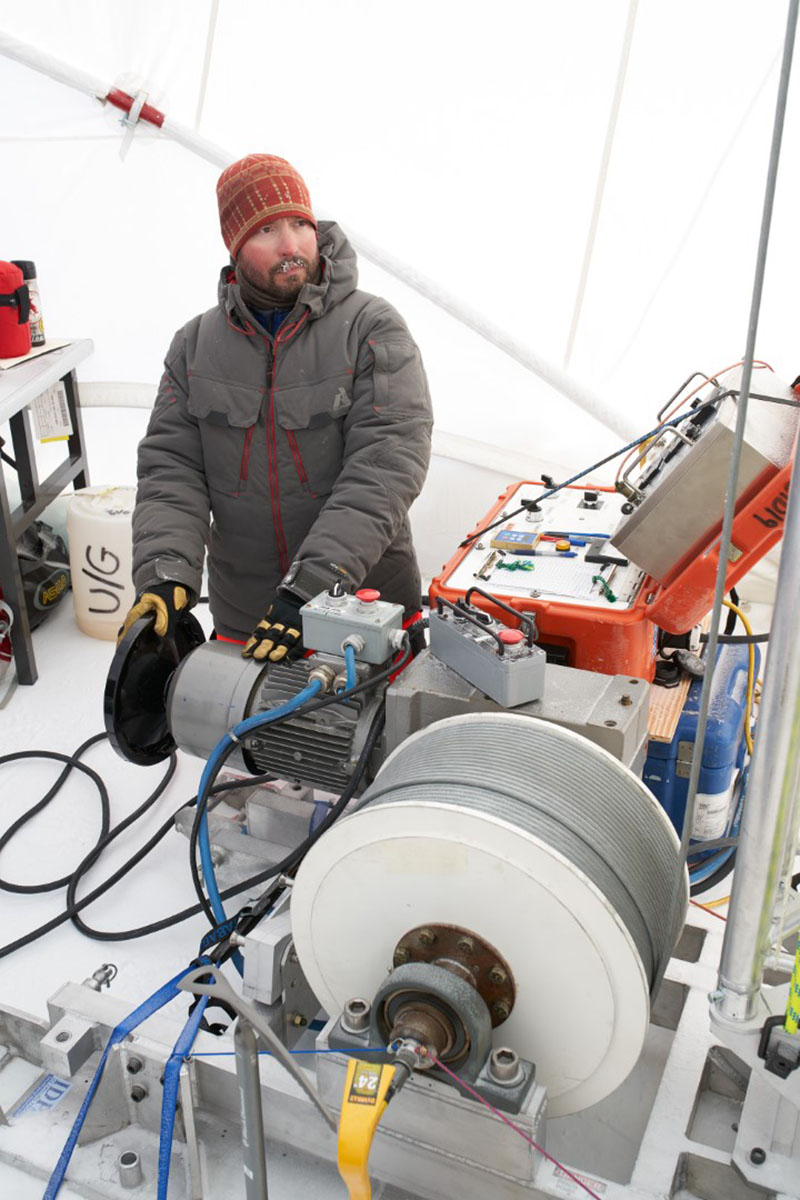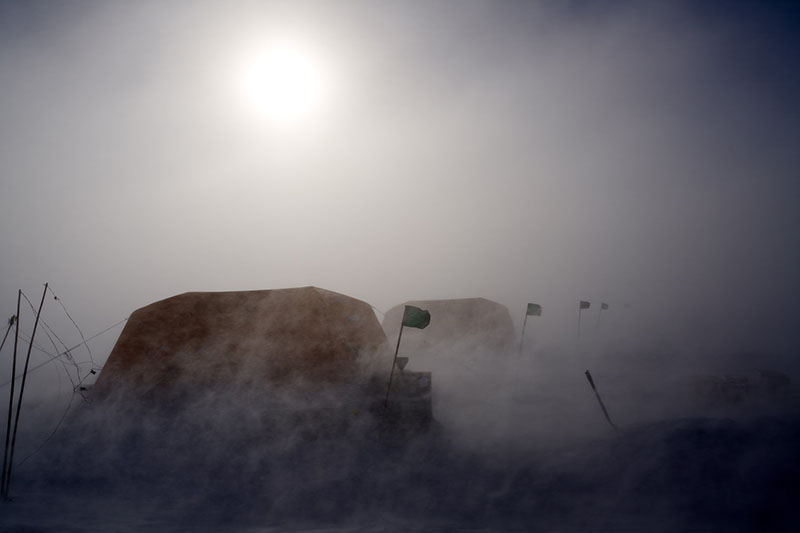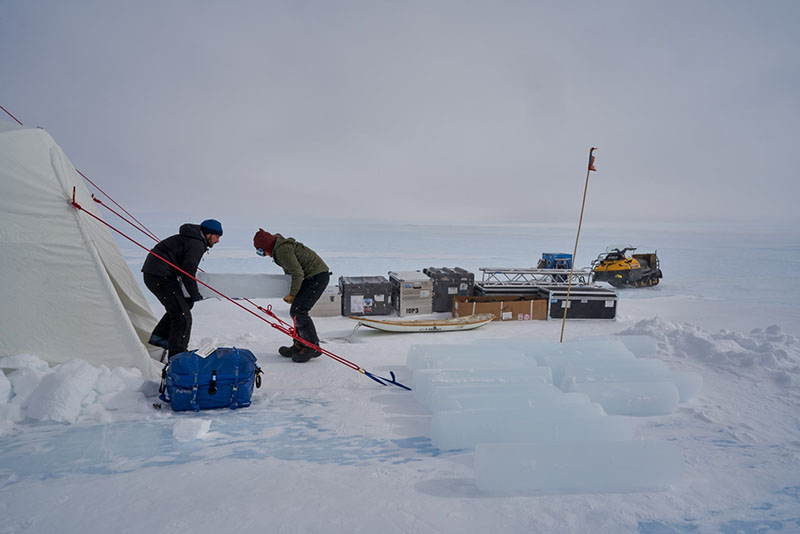Hunting For the Oldest Ice2-Million-Year-Old Antarctic Ice Helps Researchers Crack a Lingering Climate ConundrumPosted January 26, 2020
For scientists, ice cores are an indispensable window into the past. 
Photo Credit: Ian van Coller
The Allan Hills Blue Ice Area is located about 135 miles from McMurdo Station at the far end of the McMurdo Dry Valleys.
A research team using ancient ice recovered from Antarctica, announced recently that they'd identified some of the oldest air samples ever discovered, as far back as 2 million years ago, and that they're going back for more. The paper, written by Yuzhen Yan of Princeton University and published in the October 30 edition of Nature, confirmed that the team found some of the oldest ice ever recovered on Earth, and that embedded within it were pristine atmospheric samples from a time long before humans had discovered fire. "It allows us to extend the record of direct measurements of atmospheric carbon-dioxide back further," said John Higgins of Princeton University and principal investigator of the project. "We know atmospheric carbon-dioxide, a major greenhouse gas, for the last 800,000 years [but] we don't know it very well prior to that." Just as the results of the previous study were published in Nature, members of the same team were at the National Science Foundation's McMurdo Station preparing for an even more ambitious Antarctic field season collecting more ancient ice. 
Photo Credit: Ian van Coller
The tent housing the ice drill was set up on the blue ice field. Because the ice they were collecting wasn’t nearly as deep as other, bigger projects, the drill used was smaller and more portable.
"The plan is to drill adjacent holes with a much bigger drill core to recover more ice at that age with the hope that with a bigger sample we can better untangle what the records look like," Higgins said. "The second goal is essentially to prospect for even older ice… we're essentially going to punch a bunch more holes in the area trying to find stuff that's even older." The project is supported by NSF, which manages the U.S. Antarctic Program. Preserved AirFinding ice that's two million years old is remarkable on its own, but what climatologists are most excited about are the ancient air bubbles embedded within. They are the best way for researchers to understand what Earth's atmosphere was like in the prehistoric past. With it, scientists can glean insight into how the planet's climate historically responded to changing carbon-dioxide levels so they can predict what may lie ahead as today's levels climb. The bubbles form as each year's snowfall buries the snow from the previous year. Over time, as more and more annual snow builds up, the weight of the newer snow compresses the older layers below into ice. The air between the snowflakes gets trapped as the snow is compacted, becoming miniature atmospheric time capsules from millennia ago. Because this ice is formed by layering seasonal snowfall over and over, it creates stratified bands within it, akin to the rings in a tree trunk. In ideal samples, scientists can count the number of layers down from the top and pinpoint the exact year an ice layer was laid down. 
Photo Credit: Ian van Coller
Driller Tanner Kuhl operates the drill boring into the ice and retrieving ice cores.
"There's very clear evidence from geology that the Earth has had very large changes in its climate and they have been natural, no doubt about that," Higgins said. "But we think that at the same time, while they have been natural, they have been driven by changes in the carbon cycle that are no different than the changes in the carbon cycle that we are driving today." But Higgins and his team are not dealing with ideal samples. It's difficult to find sites with uninterrupted ice strata going back thousands of years. They're located usually in areas on an ice sheet called "domes," where there's a lot of snow accumulation and the ice below is spreading smoothly and evenly out in all directions without warping the layers near the bottom of the sheet. It's a major operation to collect a complete set of ice cores from these sites. Previous Antarctic Program projects like WAIS Divide and SPICECORE and the European extracted ice cores from Dome C required sizable camps, big drills and several years to drill and collect thousands of meters of uninterrupted ice. The oldest ice ever recovered from one of these sites is about 800,000 years old. Higgins and his team collected ice more than two million years old by doing almost everything differently. Both this year and their previous trip, they traveled to the Allan Hills Blue Ice Area, an ice field at the base of a cluster ice-free peaks on the western flank of the Convoy Range in the Transantarctic Mountains, about 135 miles from McMurdo Station, on Ross Island near the Antarctic coast. Their campsite and drill are much smaller than any of the major dome drilling operations, and they only sought to collect a few hundred meters of ice. With this light footprint, they were able to collect samples from multiple drill sites each season. Complicated IceUnlike a dome with its uninterrupted line of stratified ice, the ice the team collected from Allan Hills was located along the edge the glacier. The ice there is broken up, with big gaps between many of the layers. It's messy, but at the bottom of it all, they found a cache of ancient ice preserved from evaporating by layers of younger ice above. 
Photo Credit: Ian van Coller
Austin Carter (left) and Jenna Epifanio carry out an ice core from the drill tent.
"For the continuous records, basically you go out to a dome," said Sarah Shackleton, a paleo-climatologist at Princeton University. "Where we're going, the ice has sort of flowed out to the margins, and there are certain pockets of this really old ice. That isn't a continuous record for the past two and a half million years, but [it] contains ice from two and a half million years ago." Without continuous layers, dating the ice and embedded air bubbles is more complicated and less precise. So much so that glaciologists looking for ancient atmospheric samples often ignore these peripheral sites. "Nobody bothers about these marginal ice sites… because they're going to be more complicated. But it may turn out that they have extremely old ice," Higgins said. "It is certainly the case that the oldest ice anywhere on Earth is going to be complicated in the sense that that's just something we'll have to deal with." The site itself is somewhat of a glaciological conundrum. The top layers of exposed ice are relatively young—only a few hundreds of thousand years old—but they shield layers that are much older. There are lengthy gaps between layers from different eras, with ice at the base as old as 2.7 million years. Why these gaps exist and whether the younger ice originally formed on top of the older ice, or later flowed over it, is still a mystery. "We don't really understand why it's there and whether or not it's essentially stranded there and ice continues to kind of move over it," Higgins said. "The bottom line is that it seems to be a stranded piece of very old ice." Though the layers are broken up and discontinuous, Higgins and his team were able to determine the age of the ice's air pockets using a technique that measures the presence of a characteristic trace gas. "We are dating it by essentially measuring how much less of a particular isotope of argon the atmosphere had in the past," Higgins said. "About 1 percent of the air in the atmosphere today is argon. Most of that argon is a particular isotope of argon called argon-40… At the beginning of time [the atmosphere] had zero percent argon, now it has 1 percent. What we're essentially doing is measuring how much less argon the air had in it compared to today." This particular isotope of argon is produced by the decay of potassium below the Earth's surface that seeps into the atmosphere when the rocks it's embedded in weather away. It's a gradual process that happens at a predictable but slow rate. "The amount of which the isotope of our argon ratio changes is like 66 parts per million per million years, so it's a very tiny change," Higgins said. "It's a hard thing to measure." Using this technique, the team confirmed that the ice and air within it extended as far back as two million years, farther than any other atmospheric sample. 
Photo Credit: Ian van Coller
The weather at the Allan Hills camp was difficult to work in, with nearly constant gusty winds.
"The advantage of that is that it allows you to date the air in the ice directly, so we're providing an age in the air as opposed to anything else. That's what we care the most about," Higgins said. "It's not a particularly precise chronometer so the uncertainty with this oldest ice is plus or minus 100,000 years, or 10 percent of the age." Though the argon readings actually indicated that some of the ice samples extended as far back as 2.7 million years, the team could only get reliable carbon-dioxide readings to about 2 million years ago. Carbon dioxide exhalations from microorganisms seem to have contaminated the bottom layers of ice. Decoding the Glaciation CycleDespite the relative imprecision of the dating, the researchers were able to use their results to help detangle a lingering glaciological mystery. The planet is currently in the middle of a relative warm period, called an "interglacial period." However according to paleontological records, over the last three million years or so, Earth has gone through relatively regular cycles of deep glaciation, where vast swaths of the planet are covered by miles-thick ice sheets that extend across nearly all of Canada and Northern Europe. "For the last million years or so, we've been transitioning from glacial to interglacial at somewhat regular periods of about 100,000 years, but beyond a million and a half years ago, that glacial/interglacial transition was happening at about a 40,000-year frequency and there's a big question as to why the durations of the glacial periods have changed over time," Shackleton said. Scientists have suggested several theories as to the cause of the switch, but had little hard evidence to whittle down the possibilities. Using these ancient atmospheric samples, the team was able to show that likely it had little to do with the carbon dioxide content of the ancient atmosphere. "What were able to see is, in general, the highest CO2 concentrations we measure are not any different from the last 100,000 years, so CO2 was not substantially higher during the warm periods of the glacial cycle," Higgins said. Going Back For MoreThough the field season in 2015 was successful, Higgins and his team returned to the Allan Hills this year and will again next year to collect more ice. A lot more. "We're going back with two drill rigs instead of one, and both of them drill bigger cores" Higgins said. "We're going to go right next to where we drilled the holes before, same place, and now try to try to drill one with a 10-inch drill diameter instead of a 3-inch. The simplest reason is just that you can do more measurements on a 10-inch thing. I can better test ways of trying to understand how the ice is kind of layered and dipping and things like this if I have a bigger volume." The Allan Hills is a harsh site to work at. With average summer temperatures hovering in the single digits and constant blustery winds, the team had to fight the elements to collect all the samples they needed. "I think all of us (besides John, who has been to the site before) were a bit surprised by the amount of blowing snow we were dealing with," Shackleton said. "We definitely had to do a lot of maintenance throughout the season and digging out of the tents at the end of the season." After six weeks drilling at their field site, Higgins and his team recovered about 450 meters of ice from three drill holes. The cores are in the process of being transported from McMurdo Station to the National Science Foundation Ice Core Facility in Denver, Colo. where they'll be stored and processed for researchers to continue studying the ancient ice and air trapped within "The ice itself is also quite interesting. It has much larger bubbles than I've ever seen in previous ice cores, and they were deformed in depth ranges where the ice was under a lot of stress," Shackleton said. "I think there's still a lot to learn about how such old ice is preserved at this site, and if Allan Hills is relatively unique, or if there are other sites like it across Antarctica." NSF-funded research in this story: John Higgins, Princeton University, Award No. 1744993. |



For USAP Participants |
For The Public |
For Researchers and EducatorsContact UsU.S. National Science FoundationOffice of Polar Programs Geosciences Directorate 2415 Eisenhower Avenue, Suite W7100 Alexandria, VA 22314 Sign up for the NSF Office of Polar Programs newsletter and events. Feedback Form |


